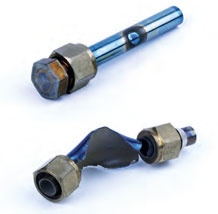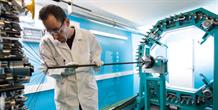What are the nuclear reactor materials concerned?
“The core of a nuclear facility is composed of countless parts and equipment, with each representing an area of investigation for material specialists”, said Benoit Tanguy, Department of Nuclear Materials (DMN) project manager at the CEA Nuclear Energy Division . First of all, there is the cladding, which is composed of long tubes with closed ends in which the fuel pellets are inserted. “They are made of zirconium alloy”. Next come the 'internal structures' comprising metal parts, partitions, reinforcements and various screws which hold them in place. “These are made of
austenitic stainless steel”. Finally, there is the reactor vessel, weighing 330 to 450 tonnes depending on the plant series: “this is made of a
low-alloy ferritic steel but is protected against corrosion on the inside by a coating of austenitic stainless steel”. Of these three core components, EDF only changes the fuel assemblies on a regular basis when the spent fuel is removed and replaced with new fuel. Apart from some of the screws, the internal structures and vessels - installed at the time of the building’s construction - are designed to stay there permanently. In the first 900 MWe PWRs, some of these parts have been in place for 37 years!
Speeding up the ageing process of materials to better model it
These non-moving components, internal structures and vessels are they able to withstand the possible extension of the plant's operating life? One of the Department of Nuclear Materials' tasks is to help build up the scientific information which will allow us to answer this question. As part of their ten-yearly inspection, each reactor is the subject of a file submitted to the ASN to justify its operation for a further decade. “The CEA is called in to help operators provide the necessary technical arguments for the vessel and internal structures”. This involves collecting material data on the ageing of these parts, for example by conducting experimental irradiations, in order to assess their properties after fifty years. At EDF’s request, the CEA teams have already started collecting information to meet the next ten-yearly inspection deadline: the sixty-year one! It is then a question of checking that the vessel’s material properties do not evolve to the point where the vessel’s integrity is called into question in the event of an accident. “We need to produce models describing how the properties of irradiated steel will evolve over the course of these 60 years”. How? By experimenting! To reproduce the stress experienced by the material inside a core, researchers age the material rapidly by subjecting it to a neutron flux in research reactors, which is higher than in reality. They then characterise the mechanical properties and microstructures of these samples at the LECI laboratory. “Added to this are a whole battery of tests conducted on metals that are not irradiated by neutrons. These can be conducted on the DMN JANNuS facility, or in collaboration with colleagues from other CEA Nuclear Energy Division departments (Physical Chemistry Department (DPC) and Department for Modelling Systems and Structures (DM2S)). The aim being to resolve a particular problem such as the mechanical strength of steels or their resistance to corrosion”.

Cladding corrosion failure test under induced stress due to iodine (top) and cladding burst test (bottom) performed in the LECI hot cells. © P.F. Grosjean/CEA

Metallography analyses on irradiated materials using the Isidore line at the LECI laboratory © P.F. Grosjean/CEA

Braiding operation on a spool for the fabrication of composite-based cladding © P.Stroppa/CEA
Foreseeing the normal wear of materials
Over and above its contribution to the regulatory files drawn up by power plant operators, the CEA Department of Nuclear Materials conducts other research. This may consist in checking that the ageing of samples in experimental reactors is typical of what would happen over the long term in a PWR. Or to supply data which will facilitate the replacement of internal screws which may fail due to a combination of mechanical stress, corrosion and neutron embrittlement. This is why EDF has launched regular campaigns to replace some of them, and conducted other research in order to better understand the phenomenon and anticipate when they are likely to fail. Finally, the Department of Nuclear Materials is also interested in the problem of swelling. “We need to look at whether irradiation over more than 40 years can result in swelling inside PWRs, as has occurred in fast reactors, and find out how to minimise this phenomenon where necessary.”
Studying cladding behaviour in accident conditions
Research on cladding focuses on improving the performance and operability of reactors. It also analyses how they behave in the event of an accident to make sure that nuclear safety is at its best. “
One of the objectives is to find solutions to minimise the damage caused to the reactor by loss of coolant after a break in the primary system”, explained Jean-Christophe Brachet, international expert at the CEA, giving as an illustration the nuclear accident at the Fukushima Daiichi NPP when the cladding was unable to withstand the core temperature rising to 1,000°C within the space of a few minutes. “
The cladding’s internal pressure suddenly increases. It can explode and then, if the cooling systems are not working (which was unfortunately the case at Fukushima), it can shatter and form, together with the fuel it contains, a radioactive magma which is extremely difficult to cool: corium. Moreover, the zirconium alloy of cladding oxidises and releases hydrogen, which increases the risk of explosion. Hence the idea of ensuring that the cladding can maintain its integrity for several more hours or even days, and also that it oxidises as slowly as possible” the expert concluded. The CEA has examined two types of solutions which have led to the registering of patents. The first consists in coating the existing zirconium alloy cladding with a chromium-based substance to reduce its oxidation rate in this type of environment by a factor of 10 to 20. The second, which is even more of a technological breakthrough and will therefore take longer to implement, aims at manufacturing new cladding using a material originally designed for Generation IV reactors: a composite material based on braided silicon carbide fibres, interspersed with a metal layer to ensure leaktightness.